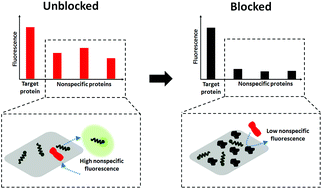Enhancing the sensing specificity of a MoS2 nanosheet-based FRET aptasensor using a surface blocking strategy
Abstract
Aptamer-based biosensing, which uses short, single-stranded nucleic acid segments to bind to a target, can be advantageous over antibody-based diagnostics due to the ease of synthesis and high stability of aptamers. However, the development of most aptamer-based sensors (aptasensors) is still in its initial stages and many factors affecting their performance have not been studied in great detail. Here, we enhance the sensing specificity of a fluorescence resonance energy transfer (FRET)-based MoS2 nanosheet aptasensor in detecting the malarial biomarker Plasmodium lactate dehydrogenase (pLDH). In this sensing scheme, the presence of target is signaled by an increase in fluorescence when fluorescently-labeled aptamers bind to pLDH and release from a quenching material. Interestingly, unlike most of the reported literature on aptasensors, we observe that non-target proteins also cause a considerable increase in the detected fluorescence. This may be due to the nonspecific adsorption of proteins onto the fluorescence quencher, leading to the displacement of aptamers from the quencher surface. To reduce this nonspecific association and to enhance the sensor specificity, we propose the application of a surface blocking agent to the quenching material. Importantly, we demonstrate that the sensing specificity of the MoS2 nanosheet-based aptasensor towards target pLDH biomolecules can be significantly enhanced through surface passivation, thus contributing to the development of highly selective and robust point-of-care malaria diagnostics.

- This article is part of the themed collection: Bioanalytical Sensors


 Please wait while we load your content...
Please wait while we load your content...